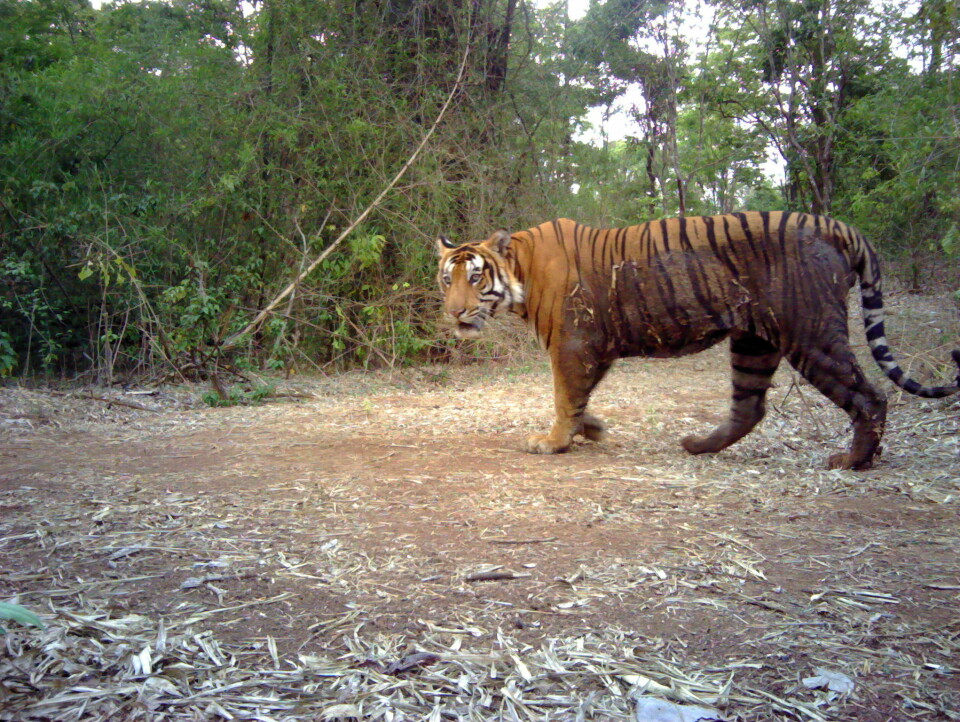This article is produced and financed by the University of Oslo - read more

Indian authorities may have exaggerated claims of rising tiger numbers
The Indian government has claimed that the national tiger population more than doubled since 2006. Independent scientists however, claim it is almost impossible for the tiger population to grow with such speed in such an inexplicable manner. Following this criticism, Indian authorities now admit to flaws in their tiger counts.
The tiger is a national symbol of India and a unique animal that draws worldwide attention. In the early 19th century, tens of thousands of tigers roamed in the forests in India and 29 other nations. Today, some 200 years later, hunting, poaching of tigers and their prey and a loss of habitat have led to a sharp decrease in the total number of tigers. Three of the nine subspecies – the Bali tiger, the Caspian tiger and the Javan tiger – are extinct. One of the six remaining subspecies – the South China tiger – is now believed to be extinct in the wild.

Worth more alive than dead
Faced with the prospect of a world without tigers, scientists, celebrities and officials from 13 nations met in St. Petersburg in Russia in 2010. The world’s first Global Tiger Summit was a highly profiled arrangement with celebrities like actor Leonardo DiCaprio and supermodel Naomi Campbell rubbing shoulders with Chinese premier Wen Jiabao and Russian strongman Vladimir Putin, who at the time was prime minister between two terms as president.
With only about 3200 tigers “guesstimated” to be left in the wild, the sole aim of this meeting was to develop a plan to double the numbers by the next Tiger lunar year, 2022. At the end of the meeting, all the participating nations declared that they would double their number of wild tigers by 2022. Donors had promised to give no less than 208 million British pounds to the conservation of one of the most charismatic and popular animals in the world.
In India, still the home of the world’s largest tiger population, official figures stated that there were only 1,411 tigers in 2006. Based on this, India’s government had every reason to be proud when they chose the International Tiger Day, July 29th 2019, to announce that the population of tigers in India had reached 2,967 animals. This was one third more than the number in 2014 – 2,226 tigers – and more than a doubling of the 1,411 animals reported in 2006.
"Conclusions based on flawed methods"
There is only one problem with the official Indian statistics: They have been based on unreliable methods, according to a recently published scientific paper that has attracted a lot of attention.
The scientists claim that the official tiger census reports are based on fundamental mathematical flaws and design deficiencies that have resulted in inexplicable ecological patterns. Independent journalists have also expressed serious concern about the lack of transparency in data-sharing with independent scientists, and they have also found serious errors in the reported photographic data.

“It is extremely unlikely that the number of tigers in India has increased in the way the government claims, because the implied mechanisms describing the tiger population change make little sense from an ecological point of view”, says Arjun Gopalaswamy. He is the Science Advisor (Global programs) of the Wildlife Conservation Society, and the first author of the newly released paper.
Professor Nils Chr. Stenseth from the University of Oslo, one of the co-authors of the new paper, agrees.
“Whenever empirical observations go against known ecological patterns, it calls for immediate scrutiny of the methodological validity of the analysis”, says Stenseth.
Tigers are territorial
One of the big problems with the official numbers is that the surveys report an initial contraction of the areas where tigers are found, but at the same time indicate that the population is rising.
“And then, there is an abrupt reversal of this pattern. This suggests a complete inversion of the famous occupancy-abundance relationship in ecology. Furthermore, the territorial nature of top predators, such as tigers, precludes the possibility of such an inverted relationship at such time scales”, says Gopalaswamy.

A central assertion in the recently published paper is that India’s claims of doubling the tiger population size over the 12-year period from 2006 to 2018 are not backed by reliable scientific evidence. However, that does not necessarily mean that the number of tigers in India is lower than the official 2,967.
“Our emphasis is on questioning the mechanism driving the change in tiger population numbers, which seems very improbable. The root of the problem lies in the fact that tigers are counted in a way that creates a lot of uncertainty. If this uncertainty is not accounted for, we may get misleading impressions of population change”, says Gopalaswamy.
When science mixes with politics
The authors of this new study refer to a study from 2018, which describes how agencies in the US, Sweden, Romania and Canada exaggerated population changes in wolves and brown bears. The scientists who wrote the 2018 paper coined the term “political populations” to suggest that the claimed changes of such populations are unreliable.
Doubling the number of wild tigers by 2022 was proclaimed as India’s official goal in 2012, with financial commitments of about 330 million US dollars pledged at the 2010 Global Tiger Summit.
“We worry that when large financial investments are made to meet ecologically unrealistic goals, it can induce social pressure or motivation bias on conservation agencies”, Stenseth comments.
“It appears that in all these cases, the authorities had the ambition of meeting targets with respect to animal numbers and it seems like they wanted to fulfil the ambition because they wanted to look good”, he adds.
In 2015, Arjun Gopalaswamy wrote a co-authored paper demonstrating mathematically the unreliability of the approach in practical situations for counting tigers. You would have to be a mathematician or statistician to understand the objections, but the paper was accepted for publication by a renowned scientific journal.
Urged to withdraw the paper
This inspired officials and scientists affiliated with the Indian government to urge the editors of the journal to withdraw the paper, without any scientific rationale. The journal decided this was unnecessary but instead invited the critics to write a formal scientific rebuttal. They waited for four years to do this, until the announcement of the 2018 census results (in August 2019). The tiger numbers back in 2015 also showed an impressive increase over the preceding four years, but Gopalaswamy was not convinced.
“Our earlier work also showed that the uncertainty about the estimates turned out to be much larger than what was reported, prompting the need for a re-analysis”, recounts Gopalaswamy.
“Claims based on unreliable scientific evidence may assist in short term fundraising, but they will be seriously detrimental in the longer term because they promote the most advertised conservation strategies instead of the most effective ones”, he comments.
“It is my opinion that wildlife management should be based on the best possible science instead of being mixed up with politics in order to make the authorities look good. This also emerges as the bottom line of Gopalaswamy’s excellent work”, professor Stenseth comments.
“This is not the first time we are subjected to reports claiming inexplicable changes in India’s tiger population size. Three decades ago, when the – now abandoned – pugmark census methodology was used, Indian officials reported a steady rise in tiger numbers until 2004. The alleged number of tigers that year was 3642, before immediately crashing to 1411. This change was then attributed to changes in counting methodology. It now seems like history is repeating itself”, says Dr. K. Ullas Karanth. He is another co-author of the new scientific paper, the Director of Centre for Wildlife Studies, Bangalore and one of the world’s foremost tiger biologists.
It is worth noting that India lost its tigers from two key reserves when the unreliable pugmark census methodology was previously used. India's latest tiger census report now reveals, like a déjà vu, that tigers were not detected in three reserves.
Response in popular media
In response to Gopalaswamy and colleagues, the National Tiger Conservation Authority (NTCA) and the Wildlife Institute of India (WII), the agencies responsible for India’s national tiger surveys, initially claimed to have rebutted the scientific findings of this new article. However, like in 2015, they responded directly in popular media with no scientific backing in a peer-reviewed journal.
“The responses in the popular media appear to invite a fresh set of doubts about the reliability of India’s tiger surveys as they, conceptually, reveal more scientific contradictions. Since all data are available, at this time it would be best to thoroughly re-analyse them”, opines Gopalaswamy.

Everybody loves the tiger
The authors of the new scientific paper feel that the tigers of India fit the description of a “political population”, but not perhaps in the same way as for instance the wolf in Norway. The wolf in Norway is highly controversial, you either love or hate the wolf, but more or less everybody appear to love the tiger in India. The tiger is also an international icon; one of the most popular endangered animals in the world.
“The national investments made for tiger conservation is indicative of a great political will to save tigers in India. This makes it all the more necessary for a robust tiger monitoring program to be put in place”, says Gopalaswamy.
The editorial in the scientific journal Nature 30 October 2019 concludes that the Indian government could be doing more if they want to save the tiger. To begin with, the government “…must trust independent scientists with the raw data, so that one of the Earth’s most iconic species can survive into the future”, wrote the editors of Nature.
Arjun Gopalaswamy feels that there is a growing trend among conservationists to generate a single, nation-wide or continent-wide, number of a target species. And even though large (often record-breaking) amounts of effort are invested, in practice, these numbers are usually accompanied by such high uncertainties that they are simply not useful for science or conservation.
"This is a global problem and not limited to India's tigers. We call for a shift in the monitoring approach itself, to a science-based approach where the emphasis shifts to generating sound knowledge that can direct conservation resources appropriate and in real time", Gopalaswamy concludes.
Indian authorities admit to flaws
The National Tiger Conservation Authority, a statutory body under the Environment Ministry of India, has recently reacted to the criticisms and proposed to overhaul its population monitoring setup.
The Indian Express writes that the NTCA has written to the Wildlife Institute of India (WII), also under the Environment Ministry and the implementing partner of India’s tiger surveys, conveying its proposal to revamp its Tiger Cell to "bring more accountability, transparency and scientific robustness" and "fill the gaps in scientific monitoring and research observed since 2006, when All India Tiger Estimation started in country".
India’s claims of having doubled its tiger numbers were widely publicized in international media, and consequently, most people around the world may believe these claims to be real.
"Scientific findings so far have indicated that the variability associated with India’s claims of tiger population size increases are perhaps much larger than currently reported. A re-analysis of India’s tiger survey data since 2006 will help understand the extent of these uncertainties", says Gopalaswamy.
References:
A.M. Gopalaswamy et.al: How sampling‐based overdispersion reveals India's tiger monitoring orthodoxy. Conservation Science and Practice. 2019; e128
Q. Qureshi et.al: Twisted tale of the tiger: the case of inappropriate data and deficient science. PeerJ. 2019; 7:e7482. Published 2019 Aug 20.
National Tiger Conservation Authority: Status of Tigers in India - 2018: summary report. Published 29/07/2019.
C.T. Darimont et.al: Political populations of large carnivores. Conservation Biology (2018), 32, 747-749.
A.M. Gopalaswamy et.al..: An examination of index-calibration experiments: Counting tigers at macroecological scales. Methods in Ecology and Evolution. First published: 23 February 2015.
Liu et al. (2018). Genome-Wide Evolutionary Analysis of Natural History and Adaptation in the World’s Tigers. Current Biology, October 25, 2018.


































